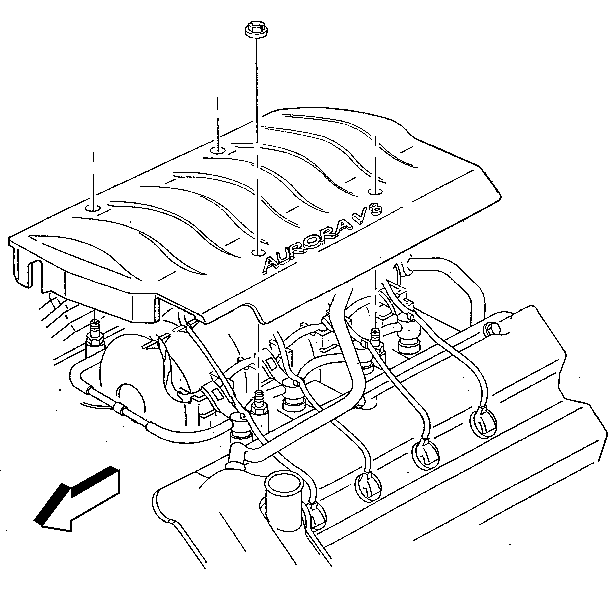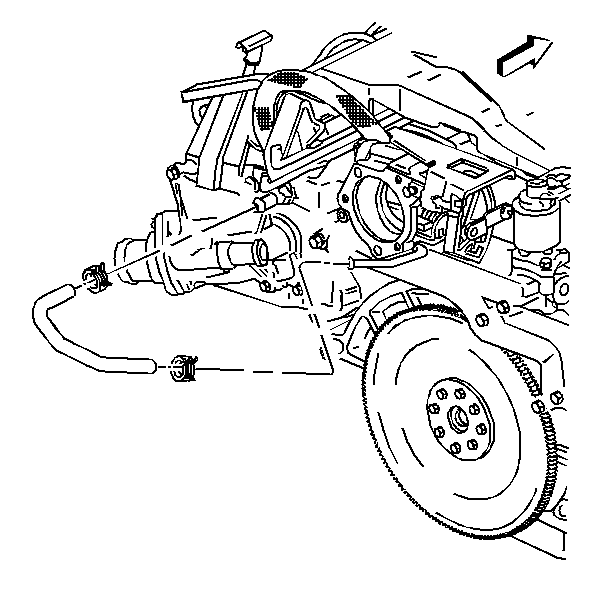Removal Procedure
Tools Required
J 37088-A Fuel Line
Quick Connect Separator Tool Set

Caution: Unless directed otherwise, the ignition and start switch must be in the OFF or LOCK position, and all electrical loads must be OFF before servicing
any electrical component. Disconnect the negative battery cable to prevent an electrical spark should a tool or equipment come in contact with an exposed electrical terminal. Failure to follow these precautions may result in personal injury and/or damage to
the vehicle or its components.
- Disconnect
the negative battery cable.
- Remove the four intake manifold sight shield nuts.
- Remove the intake manifold sight shield.
- Relieve the fuel system pressure. Refer to
Fuel Pressure Relief
in Engine Controls.
- Remove the air cleaner outlet duct from the throttle body.
- Remove the TP sensor and the IAC valve connectors.
- Disconnect the accelerator cable and the cruise control cable
at the throttle body.
- Disconnect the front bank spark plug wires and lay aside.
- Drain the cooling system. Refer to
Cooling System Draining and Filling
in Engine Cooling.

- Disconnect the throttle
body coolant hoses at the throttle body and surge tank pipe.

- Disconnect the EGR pipe
and crankcase ventilation pipe at the throttle body spacer.
- Disconnect the brake booster vacuum hose at the intake manifold
vacuum fitting.
- Disconnect the fuel rail ground wire at the rear cylinder head.
- Remove the quick-connect fittings at the fuel rail using the following
procedure:
| 14.1. | Grasp both sides of the fitting. |
| 14.2. | Twist the female connector 1/4 turn in each direction in order
to loosen any dirt within the fitting. |
| | Caution: Wear safety glasses when using compressed air in order to prevent eye
injury.
|
| 14.3. | Using compressed air, blow the dirt out of the fitting. |
| 14.4. | Choose the correct tool from the J 37088-A
for the size of the fitting. |
| 14.5. | Insert the tool into the female connector, then push/pull inward
to release the locking tabs. |
| 14.6. | Pull the connection apart. |
| 14.7. | Using a clean shop towel, wipe off the male pipe end. |
| 14.8. | Inspect both ends of the fitting for dirt and burrs. |
| 14.9. | Clean or replace the components as required. |
- Disconnect the fuel rail bracket at the left rear engine bracket.
- Disconnect the PCV hose at the intake manifold.
- Disconnect the injector harness main connector.

- Remove the six intake
manifold bolts and the four intake manifold studs.
- Remove the intake manifold.
- Inspect the intake manifold carrier gaskets. The carrier gaskets
are attached to the intake manifold through a snap-lock feature. When removing
the intake manifold, the carrier gaskets will remain attached to the manifold.
Installation Procedure

- Install the intake manifold.
- Install the six intake manifold bolts.
Notice: Use the correct fastener in the correct location. Replacement fasteners
must be the correct part number for that application. Fasteners requiring
replacement or fasteners requiring the use of thread locking compound or sealant
are identified in the service procedure. Do not use paints, lubricants, or
corrosion inhibitors on fasteners or fastener joint surfaces unless specified.
These coatings affect fastener torque and joint clamping force and may damage
the fastener. Use the correct tightening sequence and specifications when
installing fasteners in order to avoid damage to parts and systems.
- Install the four
intake manifold studs.
Important: Only tighten the intake manifold bolts when the engine and manifold
are cool. Do not tighten the intake manifold bolts and studs with the engine
at operating temperature.
When tightening the intake manifold bolts and studs, start at the center
of the manifold and work your way outward in a circular pattern.
Tighten
Tighten the bolts and studs to 10 N·m (89 lb in).
- Install the injector harness main connector.
- Install the PCV hose at the intake manifold.
- Connect the fuel rail bracket at the left rear engine bracket.
- Connect the quick connect fittings to the fuel rail using the
following procedure:
| 7.1. | Apply a few drops of clean engine oil to the male ends of the
engine fuel rail inlet and outlet tubes. |
| 7.2. | Push both sides of the fitting together in order to cause the
retaining tabs to snap into place. |
| 7.3. | Once installed, pull on both sides of the fitting in order to
make sure the connection is secure. |
- Connect the fuel rail ground wire at the rear cylinder head.
- Connect the brake booster vacuum hose at the intake manifold vacuum
fitting.

- Install the EGR pipe and
crankcase ventilation pipe at the throttle body spacer.
Tighten
Tighten the EGR pipe bolt to 25 N·m (18 lb ft).
- Connect the throttle body coolant hoses at the throttle body and
surge tank pipe.
- Connect the front bank spark plug wires.
- Connect the accelerator cable and cruise control cable at the
throttle body.
- Install the TP sensor and the IAC valve connectors.
- Install the transaxle shift cable at the bracket. Install the
air cleaner outlet duct.
- Install the fuel filler cap.
- Connect the negative battery cable.
- Turn the ignition switch to the ON position for two seconds, then
turn the OFF position for ten seconds.
- Again turn to the ON position. Check for fuel leaks.

- Install the intake manifold
sight shield.
- Install the four intake manifold sight shield nuts.
Tighten
Tighten the four intake manifold sight shield nuts to 3 N·m
(27 lb in).
- Fill the cooling system. Refer to
Cooling System Draining and Filling
in Engine Cooling.







